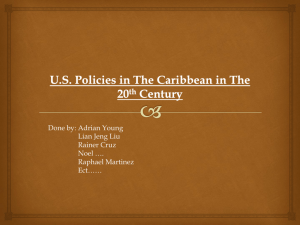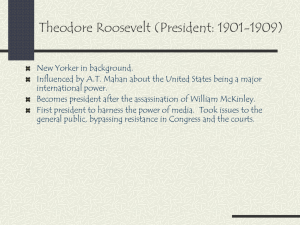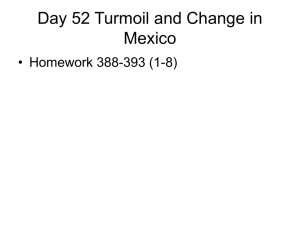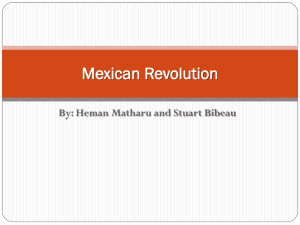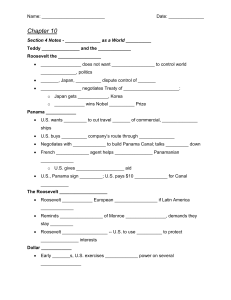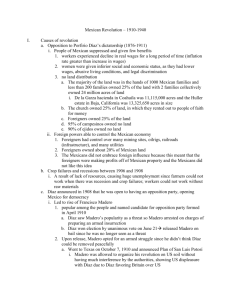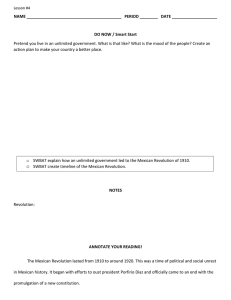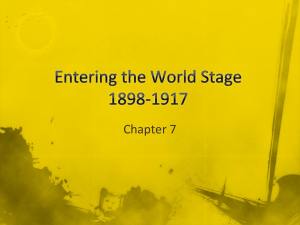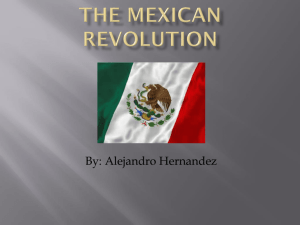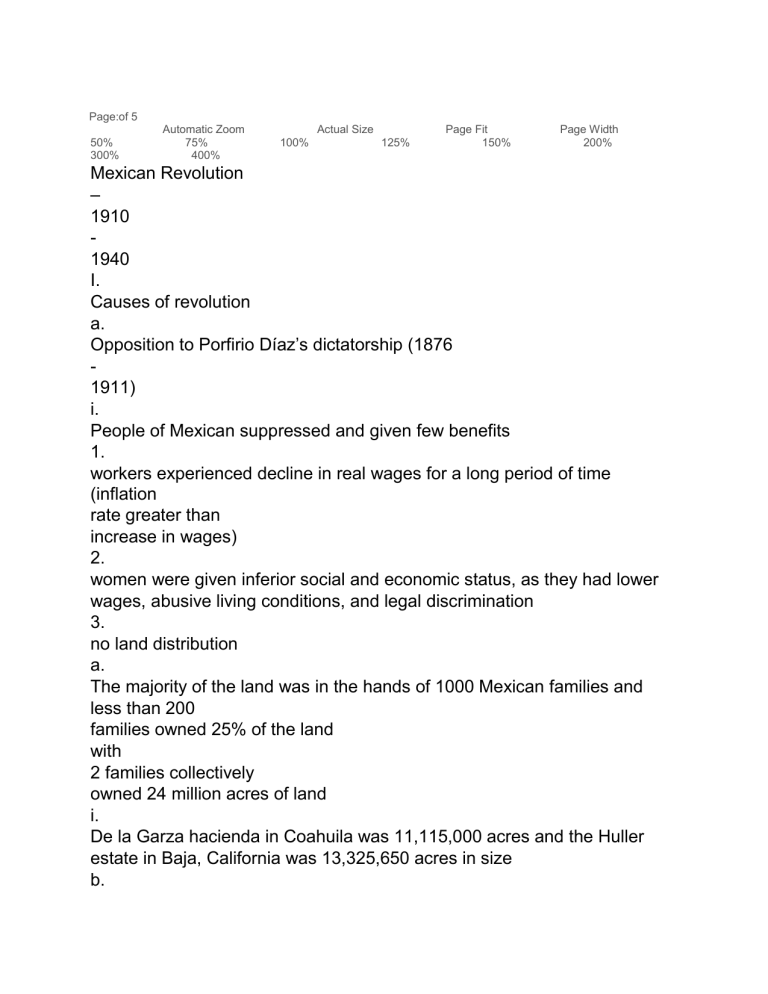
Page:of 5 50% 300% Automatic Zoom 75% 400% Actual Size 100% 125% Page Fit 150% Page Width 200% Mexican Revolution – 1910 1940 I. Causes of revolution a. Opposition to Porfirio Díaz’s dictatorship (1876 1911) i. People of Mexican suppressed and given few benefits 1. workers experienced decline in real wages for a long period of time (inflation rate greater than increase in wages) 2. women were given inferior social and economic status, as they had lower wages, abusive living conditions, and legal discrimination 3. no land distribution a. The majority of the land was in the hands of 1000 Mexican families and less than 200 families owned 25% of the land with 2 families collectively owned 24 million acres of land i. De la Garza hacienda in Coahuila was 11,115,000 acres and the Huller estate in Baja, California was 13,325,650 acres in size b. The church owned 25% of land, in which they rented out to people of faith for money c. Foreigners owned 25% of the land d. 95% of campesinos owned no land e. 90% of ejidos owned no land ii. Foreign powers able to control the Mexican economy 1. Foreigners had control over many mining sites, oilrigs, railroads ( infrastructure), and many utilities 2. Foreigners owned about 20% of Mexican land 3. The Mexicans did not embrace foreign influence because this meant that the foreigners were making profits off of Mexican property and the Mexicans did not like this idea b. Crop fa ilures and recessions between 1906 and 1908 i. A result of lack of resources, causing huge unemployment since farmers could not work when there was recession and crop failures; workers could not work without raw materials c. Díaz announced in 1908 that he was op en to having an opposition party, opening Mexico for democracy i. Led to rise of Francisco Madero 1. popular among the people and named candidate for opposition party formed in April 1910 a. Díaz saw Madero’s popularity as a threat so Madero arrested on charges of preparing an armed insurrection b. Díaz won election by unanimous vote on June 21 released Madero on bail since he was no longer seen as a threat 2. Upon release, Madero opted for an armed struggle since he didn’t think Díaz could be removed peacefully a. Went to Texas on October 7, 1910 and announced Plan of San Luis Potosí i. Madero was allowed to organize his revolution on US soil without having much interference by the authorities, showing US displeasure with Diaz due to Diaz favoring Britain over US ii. Previous elec tion in which Díaz “won” considered null and void iii. Madero provisional president until free elections could be held iv. Aimed to overthrow Díaz by use of violence v. Had vague agrarian policies and promised some land reform II. Course of revolution a. Madero’s return to M exico i. Greeted by only 25 supporters when he returned, but soon gathered momentum and two major movements (one under Pascual Orozco and Pacho Villa in Chihuahua, the other under Emiliano Zapata in Morelos) were influenced by Madero b. Complot de Tacubaya (Marc h 1911) i. Some maderistas organized an urban revolt against Díaz that advocated a revolutionary social agenda including protecting indigenous rights, agrarian reform, 8 hour workday, equal pay for equal work, and equal access to education ii. Although quickly su ppressed, it was successful in undermining Díaz’s confidence in his ability to rule seeking compromise with Madero shortly after c. Treaty of Ciudad Juárez (May 21, 1911) i. Cause: Zapatistas won two decisive victories in May Díaz decided to reach an agreeme nt with Madero instead of face an invasion by Zapata ii. Provisions 1. Díaz removed from power, but all existing institutions left 2. nothing regarding social change involved III. Madero’s presidency (1911 - 1913) a. October 1911 – elected president by overwhelming majority b. C losely tied with old regime and had no sympathy with the revolution, as attempts were made to disband the revolutionary troops c. Díaz bureaucracy remained largely intact d. No fundamental solutions for social and economic problems (little change) e. Conception of democracy was that masses had illusion of power while all decisions in hands of elite f. Allowed organization of trade unions, strikes, and national workers’ center g. Answer to agrarian problem was an inadequate program of purchase of land from large landowners and recovery of national land for distribution among the landless peasants i. Failure of agrarian reform lost him trust and support from peasants h. Madero seen as incompetent, so Zapata attempted to overthrow him i. Plan of Ayala (November 28, 1911) – stated “the lands, woods, and waters usurped by the hacendados, científicos, or caciques through tyranny and venal justice” would be returned to their owners ii. Madero failed to stop the revolt i. Loss of US support because he didn’t favor Americans i. February 12, 1913 – Wil son sent Madero a protest against the military operations conduct in Mexico City since they threatened American life and property ii. February 14, 1913 – Wilson invited other foreign diplomats to conference and it was agreed that they would force Madero to res ign j. February 18, 1913 – some of Huerta’s troops arrested Madero and a few others i. Huerta headed provisional government; Félix Díaz (nephew) would be given chance once elections could be held IV. Huerta’s regime (1913 1914) a. “Proper” elimination of Madero – Huert a obtained “voluntary” resignations from Madero and his VP; the two were then murdered on February 22 on way to penitentiary b. Seizure of power was greeted warmly by landed aristocracy, capitalists, and church c. Biggest effort was to restore Díaz’s system of p ersonal dictatorship d. Félix Díaz would never succeed Huerta e. Continued Madero’s labor policies, but later closed down Casa del Obrero Mundial when labors aligned themselves with the anti Huerta movement f. Revolutionary wave grew even stronger with Madero’s mur der and dictatorship g. Zapata intensified fight; anti Huerta coalition formed in North i. Huerta’s campaigns against Zapatistas failed to gain any decisive victories ii. Zapata forced Huerta to commit a large amount of troops to south (where he was attacking), whic h allowed northern revolutionary movement to succeed h. Favored Britain over US US opposed Huerta i. Woodrow Wilson refused to recognize Huerta regime because he was convinced Huerta could not provide the stable political climate US interests required ii. November 1913 – Wilson sent note to British officials basically stating that the US “intends not merely to force Huerta from power, but also to exert every influence it can exert to secure Mexico a better government under which all contracts and business concessio ns will be safer than they have been” make Mexico more US friendly iii. Wilson obtained end of British support for Huerta in 1914 by yielding to British request for uniform rates on all goods shipped through the Panama Canal Huerta’s financial position beca me increasingly difficult 1. Tried avoiding trouble by suspending payment on interest on national debt for 6 months, but that only increased his difficulties iv. US lifted existing embargo on arms shipments to Carranza’s forces after they promised they would resp ect foreign property rights v. Dolphin Incident – Dolphin cruiser landed in restricted area of Tampico, and US sailors aboard were arrested but quickly released with an apology 1. commander of Dolphin demanded formal disavowal of actions and various other things that was the equivalent of political suicide 2. fleet sent into Gulf of Mexico and on April 21, 1914, Wilson ordered seizure of Veracruz after learning a German merchant ship with munitions was on the way 3. Huerta’s forces evacuated; US occupied Veracruz Mex icans not too happy vi. Huerta fled for Europe on July 15, 1914 after Villa and Obregón seized many important cities US had no pretext for continuing armed intervention, but Wilson delayed evacuation of Veracruz as long as possible in hope of securing commit ments from Carranza that would prevent any basic changes in Mexico’s social and economic structure; Carranza rejected demands and insisted on ending military intervention US evacuates on November 23, 1914 because they feared revolutionary convention’s ra dical threat to US economic interests (especially oil) V. Pancho Villa a. Pancho Villa, leader of the northern anti Huerta movement, won control of Chihuahua after capturing Chihuahua City b. Employed soldiers as civil militia and administrative staff to restore no rmal life c. Reduced meat prices and distributed money, clothing, and other goods to the poor d. Established about 50 new schools in Chihuahua City (very passionate about education) e. December 1913 – announced expropriation without compensation of pro Huerta oliga rchy holdings in Chihuahua i. These lands remained under state control until victory of revolution ii. Revenues from estates used to finance revolution and support windows/orphans of soldiers iii. Once victory achieved, used to pay pensions to windows/orphans, to comp ensate veterans, to restore village lands taken by hacendados, and pay taxes left unpaid iv. Cattle on the lands sold to US for arms/ammunition for army, given to urban unemployed for food, or sold in markets f. in 1914, he seized Torreón (major railroad center), Monterrey, Saltillo, Tampico, and Zacatecas leading to flight of Huerta g. after 1915, he ceased to exist as a major political and military factor i. forced out of Mexico City by Carranza (January 19, 1915) ii. attacked by Obregón in April 1915 in railroad center of Celaya (first time Villa suffered disastrous defeat) iii. by end of 1915, he was in Chihuahua; carried on guerrilla warfare for three years but nothing major VI. Emiliano Zapata a. Essentially took land from haciendas and distributed it to the peasants b. Plan of Aya la (see III.h.i) c. Anarchist; never achieved presidency VII. Venustiano Carranza a. Landowner in Coahuila who served under Díaz but joined Madero in 1911 b. March 26, 1913 – announced Plan de Guadalupe i. Called for overthrow of Huerta and restoration of constitutional go vernment ii. Did not mention anything on social reforms c. assumed title of first chief of the Constitutionalist Army d. able to recruit Villa and Alvaro Obregón, leader of anti Huerta group in Sonora e. disproved of US action in Veracruz and demanded immediate evacuat ion f. after flight of Huerta, hostility emerged between Carranza and Villa i. Carranza had no position on agrarian problem, role of church, and new political order Villa proposed a clause which Carranza unwillingly agreed to 1. defined the present conflict as a struggle of poor against abuses of power 2. implant democratic regime 3. secure well being of workers and emancipate peasants economically 4. equitable land distribution and “whatever else is needed to solve the agrarian problem” ii. October 1914 – meeting at Aguascali entes to settle differences between Villa/Carranza 1. endorsed Plan of Ayala, assumed supreme authority, and called for Carranza resignation with General Eulalio Gutiérrez provisional president 2. Carranza refused to resign armies of Zapata and Villa advanced to capital and occupied it, forcing Carranza to flee to Veracruz iii. December 4, 1914 – two came to agreement; decided Guitiérrez would have state power since both were unskilled in politics 1. Guitiérrez sabotaged Conventionist war effort and opened secret negot iations with Obregón 2. convention unable to forge a clear national program of socioeconomic reforms that could unite interests of peasantry, industrial workers, and middle class 3. Constitutionalists (headed by Carranza) adopted a program of social reforms desi gned to win the support of the peasants and workers “Adiciones” g. “Adiciones” to the Plan of Guadalupe (December 1914) i. promised agrarian reform and improved conditions for industrial workers ii. January 6, 1915 – restored lands usrped from the villages and exp ropriated additional needed land from haciendas while secretly promising hacendados that he would return land confiscated by revolutionary authorities, a promise he kept iii. Gained labor support by promising minimum wage law that applied to all branches of ind ustry and by affirming right to form trade unions and to strike iv. Appealed for women’s support h. Brought back Casa del Obrero Mundial after fall of Huerta i. Gained support of US could exercise more power with less opposition j. Early 1915 – captured Puebla and th reatened the capital Gutiérrez left the city and shortly after submitted his resignation i. Pressured Villa and forced him to evacuate Mexico City on January 19 k. October 1915 – Wilson acknowledged Carranza’s presidency and placed arms embargo on Carranza’s o pponents i. US still wanted to have significant influence on the revolution, so a memorandum to Carranza dictated the conditions to be met before he could obtain de jure recognition ii. Basically stated that US could determine Mexican policy in foreign economic rights, role of the church, elections, etc. Carranza rejected l. US/Mexican relations deteriorated sharply in 1916 i. Mexican federal/state authorities tried to regulate foreign oil company operations ii. Villa raided Columbus, New Mexico because angered at arms e mbargo 1. US responded by sending General John Pershing to pursue Villa into Mexico 2. Carranza denounced invasion, demanded withdrawal, and prepared for war 3. Wilson accepted offer to negotiate settlement after Pershing failed to get Villa m. Constitution of 1917 VIII. Al varo Obregón a. IX. Plutarco Elias Calles a. X. Lazaro Cardenas
